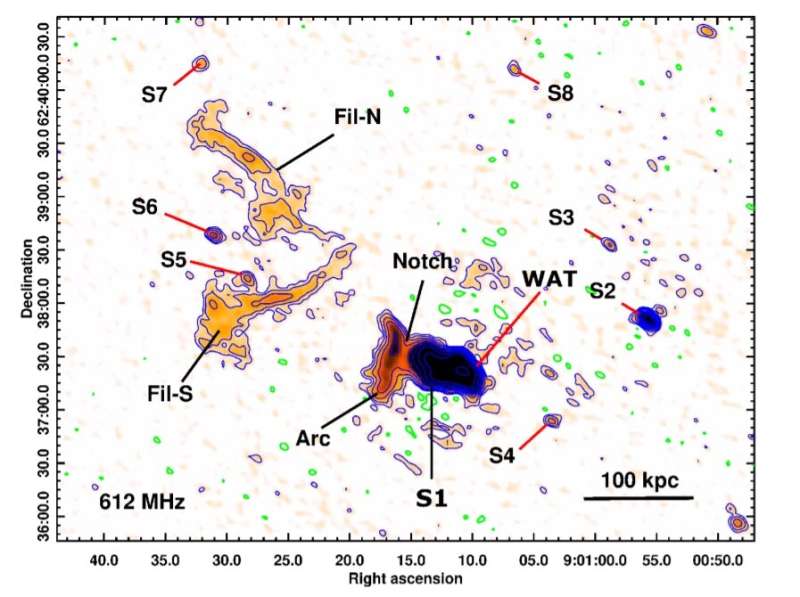Radio image of the core of Abell 725 at 612 MHz (GMRT). Credit: Pandge et al., 2021.
Using the Giant Metrewave Radio Telescope (GMRT), Indian astronomers have conducted radio observations of a galaxy cluster known as Abell 725. Results of this observational campaign deliver important information regarding the structure and morphology of Abell 725, revealing the presence of diffuse filaments in this cluster. The study was presented in a paper published October 7 on arXiv.org.
Galaxy clusters contain up to thousands of galaxies bound together by gravity. They are the largest known gravitationally bound structures in the universe, and could serve as excellent laboratories for studying galaxy evolution and cosmology.
At a redshift of 0.09, Abell 725 (A725) is a cluster of galaxies with an X-ray luminosity of 80 tredecillion erg/s and a velocity dispersion of about 534 km/s. These parameters suggest that it is a poor galaxy cluster—with richness class 0. The total mass of this cluster within a radius of 2.56 million light years is estimated to be 114 trillion solar masses.
Previous observations of Abell 725 have identified a bright radio source associated with the brightest cluster galaxy (BCG). Moreover, a diffuse radio emission has been detected at the core of the cluster that was classified as a radio relic.
In order to shed more light on the radio properties of Abell 725 a team of astronomers led by Mahadev Pandge of the Dayanand Science College in Latur, India, employed GMRT to perform multi-frequency radio observations of this cluster. The study was complemented by optical data from the Sloan Digital Sky Survey (SDSS), X-ray data from the ROSAT satellite, as well as multi-wavelength archival data.
The researchers detected two steep-spectrum diffuse filaments in Abell 725, along with a previously reported arc-like structure, and a wide-angle tail (WAT) radio source associated with the BCG at the periphery of the cluster. It was noted that some of these features could be from the past activity of the nucleus of the BCG.
The study suggests that the WAT radio source and the arc are connected structures, while the filaments are detached from them, but are found to be along the trail of the WAT. Therefore, the astronomers assume that the WAT source is a radio galaxy with trailing antique filaments.
The observations found that the BCG is at a distance of about 277,000 light years from the arc-like structure, while the filamentary structures are displaced from this structure by some 300,000 and 665,000 light years. The authors of the paper suggest that these structures result from different stages of radio activity along the path of the WAT, and these distances are typical values for such a scenario.
Furthermore, the research found that the spectral ages of the WAT and filaments are 37.1 and 93.1 million years, respectively. The mass of the black hole at the core of the WAT was estimated to be 1.4 billion solar masses, what is rather a high value when compared to that of similar known WATs.
Summing up the results, the astronomers concluded radio properties of the WAT radio galaxy resemble that of typical Fanaroff-Riley Class I (FRI) radio galaxies. They added that the WAT source may be a low-excitation radio galaxy (LERG).
More information: M. B. Pandge et al, GMRT unveils steep-spectrum antique filaments in the galaxy cluster Abell 725. arXiv:2110.03153v1 [astro-ph.CO], arxiv.org/abs/2110.03153
© 2021 Science X Network
























